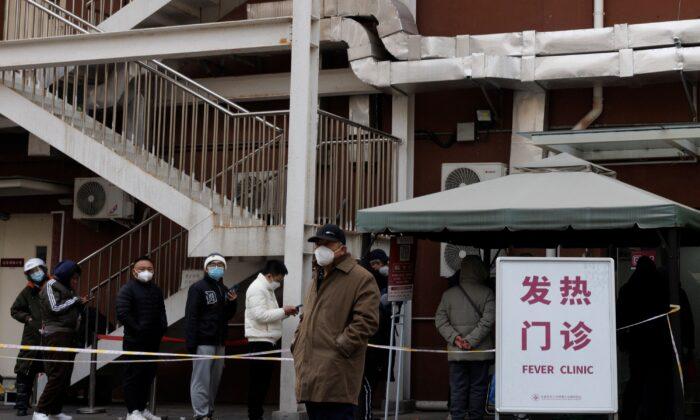The Chinese communist regime has just abruptly ended the zero-COVID policy that it had strictly enforced for the past three years. However, an unprecedented outbreak of the virus had already begun in the final months of the policy, which now is bringing the country’s weak medical system to the brink of collapse.
On Dec. 7, the Chinese State Council issued the “New Ten Rules” on epidemic control, including relaxing measures such as allowing self-isolation at home and not requiring negative PCR tests for cross-regional travel.
Tsunami of Infections
Over a fortnight, Beijing has become engulfed by a tsunami of COVID cases.On Dec. 11, the number of fever outpatients in the city’s hospitals reached 22,000—a 16-fold increase from a week earlier. The daily emergency hotline calls exceeded 30,000, which is six times the normal call volume.
Beijing resident Tang Yun (a pseudonym) told The Epoch Times on Dec. 14 that local hospitals were full, and patients were lining up outside.
“Many people with serious illnesses cannot be hospitalized because there are not enough beds or [intensive care units],” he said.
A poll conducted by Beijing media outlet The Beijinger showed that as many as 70 percent of respondents said they had contracted COVID-19.
Beijing resident Guang Yuan told The Epoch Times on Dec. 14 that most of the people he knows have been infected.
“My two brothers’ entire families are infected. My friend Mr. Song, whom I just called, said his entire family is infected; another friend Mr. Yang’s family is also infected. Almost everyone I know of is infected, except my sister and my mother, who is over 90. But I don’t think they can hold along much longer.”
Feng Zijian, the former head of China’s Center for Disease Control and Prevention, told China Youth Daily that up to 60 percent of China’s population will likely be infected in this first major wave.
And then, “eventually, about 80-90 percent of the population will be infected,” Feng said. That means in China, more than 1 billion people will be infected with the virus.
An unprecedented “winter wave” of COVID infections could occur in China, with daily fatalities expected to peak at 20,000 in mid-March, according to Wigram Capital Advisors, a macroeconomic advisory group that has provided modeling to governments during the pandemic. Demand for ICUs should peak at 10 times higher than hospital capacity by late March, when daily hospitalizations could hit 70,000.
Outbreaks Have Fast Transmission
Professor Ben Cowling, head of the Department of Epidemiology at the University of Hong Kong Li Ka Shing Faculty of Medicine, told NPR that COVID-19 is spreading faster now in China than it did anywhere else during the pandemic. It also appears to be particularly contagious among the Chinese population.At the onset of the pandemic in early 2020, the reproduction number for the virus was about 2 or 3, and during the Omicron surge in the United States last winter, it jumped to about 10 or 11, Cowling said.
In the current outbreak in China, scientists at the Chinese National Health Commission estimate that the number is as high as 16, spreading faster than previous waves around the world.
“This is a really high level of transmissibility,” Cowling told NPR. “That’s why China couldn’t keep their zero-COVID policy going. The virus is just too transmissible even for them.”
Last winter, the number of cases in the United States doubled every three days or so, Cowling said. “Now, in China, the doubling time is like hours. Even if you manage to slow it down a bit, it’s still going to be doubling very, very quickly. And so the hospitals are going to come under pressure, possibly by the end of this month.”
Cowling believes that the reason for such explosive transmissibility is that Chinese people have very little immunity to the virus, as the vast majority of them have never been infected. Until recently, China’s ruling communist party has focused on mass quarantine, testing, and travel restrictions to prevent the virus from spreading around the country. As a result, most people weren’t exposed to the variants that appeared before Omicron. But this means that almost all of the 1.4 billion people are now vulnerable to infection.
Weak Foundation of Health Care System
China’s fragile health care system is facing a major test.According to the Organization for Economic Cooperation and Development, in 2020, there were 28.2 ICU beds per 100,000 people in Germany, 21.6 in the United States, and 13.8 in Japan.
In November, the People’s Daily cited data from the State Council’s epidemic prevention and control experts as saying that China has less than 4 ICU beds per 100,000 people. Jiao Yahui, director general of the Medical Department of the National Health Commission, presented better figures, claiming that there are currently 138,100 critical care beds nationwide. Based on China’s population of 1.4 billion, this translates to 9.8 critical care beds per 100,000 people.
The number of people infected with COVID in the United States during a significant wave in the month of January reached 20,148,614. However, even with 20 million people becoming infected, ICU beds across the country were not “overloaded,” although 19 states had less than 15 percent of their ICU beds left.
Hong Kong has about 7.1 ICU beds per 100,000 people, which is about twice that of ICU beds in mainland China, according to data cited by the People’s Daily. But as the fifth COVID wave hit Hong Kong in February this year, its ICU beds were overcrowded and many hospitals were forced to set up tents outside emergency rooms to temporarily house critically ill patients.
Beijing’s ambulance system is also being pushed beyond its limits. According to the Chinese media Economic Observer, from 11 a.m. to 3 p.m. on Dec. 14, a nursing home had been trying to solve an emergency situation for an elderly person. The staff kept calling the emergency number 120 from four phones, but couldn’t get through for an ambulance because the line was always busy.
Zhang Yihe, a well-known Beijing-based writer, told The Epoch Times on Dec. 15 that the foundation of China’s medical system is weak.
“For many years, we have not invested enough in the construction of basic health care,” she said. “The authorities are very much into high-end research, but ignore the foundation, the basics, and the ordinary ... When an epidemic strikes on a large scale, of course, everything is inadequate. That’s the lesson.”
The problem of an insufficient health care system had existed before the pandemic. By 2020, there were fewer than three doctors for every 1,000 people, lagging behind major developed countries and Brazil, a developing country.
In addition to the scarce number of doctors per capita, China’s health care resources are unevenly distributed. For the estimated 500 million Chinese living in rural areas, there are fewer than two doctors for every 1,000 people, while in Beijing and Shanghai, there are more than five doctors for every 1,000 people.
As the Lunar New Year approaches, the flood of people returning to their hometowns will bring many people from the cities to the countryside.
Tang Yun, a Beijing resident, told The Epoch Times that currently, the epidemic is very serious in the big cities, but there have been relatively few cases in rural areas.
However, “when the New Year migration begins, people will bring the virus to the countryside and a second wave of outbreaks will start in the countryside.”





Friends Read Free